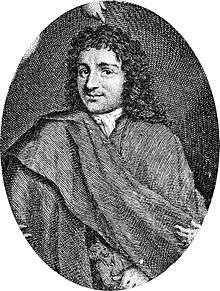Francis van Bossuit

Francis van Bossuit (1635, Brussels – 1692, Amsterdam), was a Flemish sculptor, working mostly in terracotta, wood, and ivory.[1]
Biography
According to the RKD, he travelled to Rome and joined the Bentvueghels with the nickname "Waarnemer" (meaning delegate, observer, or reporter).[1] He worked with Barent Graat and Matthys Pool and consorted with Florentine academy students.[1] He travelled back north around 1680 with the painter Bonaventura van Overbeke.[1] He is known for ivory and wood sculptures, and his motiefs became popular and are found in the works of other contemporary artists such as Jan van Mieris and Willem van Mieris, Ignatius van Logteren, Barend Graat, and Nicolaas Verkolje.[1]
According to Roeland van Eynden and Adriaan van der Willigen, in their Geschiedenis der Vaderlandsche Schilderkunst, he was given the title "Waarnemer" by his bent friends in Rome due to his precies observations of the classic statues there. Equipped with the skills to create poetic sculptures, he returned north with Bonaventura van Overbeek, and became an internationally recognized artist due to the unusual tenderness of his ivory sculptures of the classics.[2] His international fame was probably mostly due to the educational book published in 1727 by Matthys Pool called Cabinet de l'Art de Sculpture, with engravings after drawings of his works that illustrated stories from Ovid and other classics.
 Susanna and the Elders, ivory sculpture by Francis van Bossuit, Getty Center
Susanna and the Elders, ivory sculpture by Francis van Bossuit, Getty Center Engraving after the same ivory sculpture, by Willem van Mieris
Engraving after the same ivory sculpture, by Willem van Mieris- Engraving after the same ivory sculpture, by Matthys Pool after a drawing by Barent Graat
| Wikimedia Commons has media related to Francis van Bossuit. |
References
- 1 2 3 4 5 Francis van Bossuit in the RKD
- ↑ Biography of Francis van Bossuit in Roeland van Eynden and Adriaan van der Willigen's Geschiedenis der Vaderlandsche Schilderkunst, 1840, Vol. I, p. 150 (reprint 1979)
- 2984 in The Harleian Miscellany: Cabinet de l'Art de Sculpture, par Francis van Bossuet, execute en Yvoire ou Ebauche en Terre gravees d'apres les Desseins de Barent Graat, par Mattys Pool, relie en Maroquin doree Amft. 1727
- Francis van Bossuit on Artnet